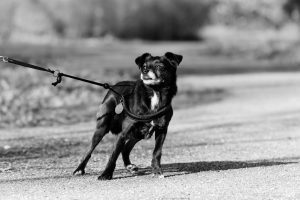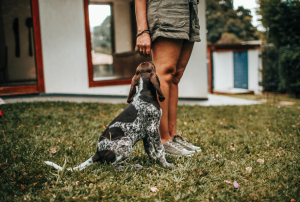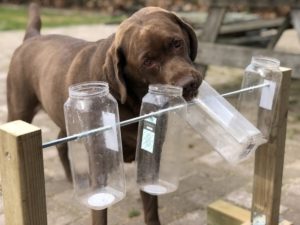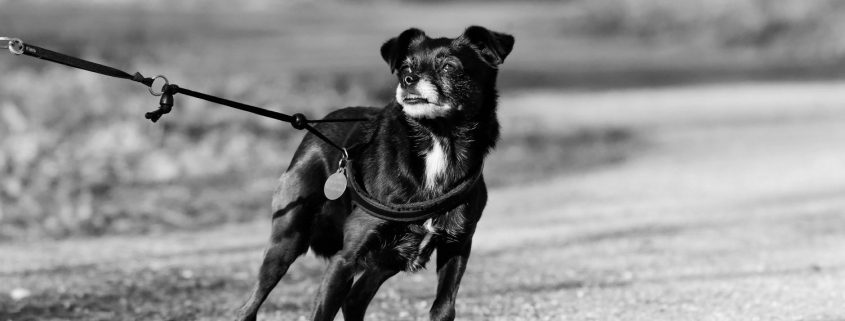Ask Crystal: Reactive Dog 101

Dear Crystal,
My dog pulls a lot and barks at most dogs. He is a Pomeranian/ Spitz. How do I stop this?
Sincerely,
Barky Pup
Dear Barky,
Reactivity is a very common problem in dogs and even yours truly has two reactive dogs currently and pretty much have always had at least one. Reactivity just means a dog that overreacts to a stimulus. This usually manifests as barking and lunging. The motivation for the behavior can be excitement, frustration at not being able to get to the other dog or it can be fear related.
If he pulls only in conjunction with seeing the other dogs, working on that reactivity is going to be key to improving the behavior. If he pulls all the time, you will also need to work on his leash walking skills. Make sure he has a no pull harness to help mitigate the pulling and the damage that is happening to his neck if he wears a collar while he is lunging and pulling.
It is very important that we start out leash training and really all training inside the home. The idea being to start training where the dog will be least distracted and can be successful. We can’t expect them to learn a brand-new behavior while they are very excited and distracted. If you can’t get the behavior, you can’t reinforce it so your job as the trainer is to figure out how to help the dog be successful.
In both leash walking training and reactivity, being able to get your dog’s attention is the first order of business. If you can’t get your dog to pay attention to you, you aren’t going to be able to help him with either problem. There are a variety of different options for working on attention.
 Teach your dog an auto check-in so that they learn to check in with you every several seconds. To train this, stand inside with the dog on a leash and mark and treat any times the dog turns to look at you.
Teach your dog an auto check-in so that they learn to check in with you every several seconds. To train this, stand inside with the dog on a leash and mark and treat any times the dog turns to look at you.
If your dog doesn’t offer check-ins or eye contact, work on eye contact games such as Up/Down and Ping Pong. To train Up/Down, stand in front of your dog and when they make eye contact say “yes” and drop a treat on the ground in front of you and repeat. Ping Pong is the same concept except take turns tossing the treat to the right and left rather than dropping it in front of you.
Teach a positive interrupt to refocus your dog to you. A noise often works well for this as many dogs can tend to tune out to human words, especially those with very talkative owners. I like to use a kissing noise. Make the noise and feed a treat and repeat many times. When your dog becomes conditioned that the sound means food, incorporate eye contact. Make kissing noise, wait for eye contact and treat.
It is important to have trained behaviors which helps with management when unexpected encounters occur. Find It teaches the dog to search the ground for treats. If his nose is engaged and pointed down, he is less likely to notice the trigger. Many dogs really enjoy this game, so it may help to create a positive association with other dogs. The Emergency U-Turn is an escape cue to get the dog moving in the opposite direction in a fun, upbeat way.
There are some cues that you can work on which will help teach your dog to build up their frustration tolerance. Wait at doorways and for food bowls is an easy behavior to teach and teaches the dog to wait for a moment before getting something they want. Leave It is a very useful cue that teaches a dog to leave something and come back to you.
What walking with your dog looks like will depend on your own preferences and you may take different kinds of walks. In general, we are looking for loose leash walking which is where the dog’s leash is in a nice smile shape so a good amount of slack in the leash. I would suggest also working on attention walking which is walking where you get the dog to focus on your face or your hand with a lure in it. I like this type of walking for a reactive dog because if the dog is mostly focused on looking at you, you will see his triggers before he does and either move in a different direction or step off far enough away so that you can distract him as it goes by.
Start your training inside the house with the dog either on or off leash. You can always start the training without the leash and add it later. I like this technique for people who tend to pull the dog around with the leash. A leash is simply an emergency brake when you need something to stop the dog from running off.
This training is about teaching the dog where you want them to be. In general, I want my dog to be by my side. I will allow them to be slightly out in front as long as the leash is not taunt but they only get treats for walking by my side. Start with the dog next to you, say “yes” or click and feed a treat. Do this several times in a row. Then try to walk one tiny step and say “yes” and treat as the dog walks towards you. Repeat many times over several days if needed. I like to use my dog’s kibble for this training if they will work for it and that is how they get fed. If your dog won’t work for kibble use as high value treats as necessary.
As your dog is successful consistently with one step at a time, slowly add one step at a time between treats. 80% or better response rate is the gold standard for your dog really knowing a behavior, so I usually add a step when the dog is performing at 80%. Once you have added a few steps, start working outside in the yard but be sure to cut down on the steps you are taking so that the dog can be successful in the more distracting environment. You will probably need to use better treats outside as well to compete with the environment.
Taking a reactive dog for a walk can be a challenge. First, identify your dog’s threshold. That is the distance at which your dog begins to react. Ideally, we always keep the dog at a distance where they will either not notice the other dog or not react to the other dog. For some dogs that distance can be quite long and that makes preventing reactive episodes difficult. The area that you are walking in is also important. It needs to have enough room to move far enough away from triggers. Streets that have cars, bushes or other visual barriers are helpful to use as visual blocks if another dog is within the threshold distance. Certain times of day tend to be busier, so choosing walk times that are less busy is important. There are often places to walk your dog such as school grounds after hours that have space to roam and where you will be unlikely to encounter other dogs. Owners of reactive dogs become very creative in finding quiet places to walk their dogs.
Many dogs can live happy lives without going on neighborhood walks. There are many ways to provide the exercise and enrichment a dog needs without going on walks. For many of these dogs not going on walks will benefit them much more than going out and facing exposure to triggers.
 The easiest way to mentally stimulate a dog is through feeding exclusively with enrichment toys and/or scatter feeding. Dogs are scavengers by nature and finding food would normally take hours a day in the wild. Hide kibble in the grass or in various places in the yard or house. You can also start hiding kibble in boxes around the house or yard as the dog starts to get the hunting game. If you want to purchase feeding toys, there are many choices on the market, such as Kongs, Kong Wobblers, Gyros, etc. Other options for entertainment will depend on your dog’s preferences. A kiddie pool can be filled with water for those dogs that like swimming. Or you can turn it into a sandpit for digging for toys buried inside.
The easiest way to mentally stimulate a dog is through feeding exclusively with enrichment toys and/or scatter feeding. Dogs are scavengers by nature and finding food would normally take hours a day in the wild. Hide kibble in the grass or in various places in the yard or house. You can also start hiding kibble in boxes around the house or yard as the dog starts to get the hunting game. If you want to purchase feeding toys, there are many choices on the market, such as Kongs, Kong Wobblers, Gyros, etc. Other options for entertainment will depend on your dog’s preferences. A kiddie pool can be filled with water for those dogs that like swimming. Or you can turn it into a sandpit for digging for toys buried inside.
Adding structured play into your dog’s exercise routine will provide an additional level of exercise with minimal effort on your part. Structured play means incorporating training into play sessions. When combining play and training, we are using the strong reinforcement of play with impulse control training. Impulse control helps your dog learn to wait patiently for the things they want. It also helps teach them to stay calm when exciting things happen. Some examples of structured play are two toy fetch, tug with rules, and flirt pole with rules.
Reactivity is an emotional issue. While we work to manage the dog’s behavior to keep him sub-threshold, we should also strive to change his emotions surrounding his trigger. Counter-conditioning is used to change a dog’s emotional reaction to a trigger. We change his emotional response by creating a new association of the trigger with something the dog enjoys. This is usually done with high value treats, but it could be play with a favorite toy or even an activity that the dog enjoys.
There are many techniques for counter-conditioning. Do your research and work through different techniques to find what works for your dog. The Open Bar technique means feeding the dog a steady stream of treats when the trigger is in sight and stopping as soon as the trigger is out of sight. The Look At That technique reinforces the dog for looking at the trigger and then looking back to the handler. The CAT technique (“Constructional Aggression Treatment”) allows the dog to move away from the trigger when he shows a more acceptable behavior. The BAT technique (“Behavior Adjustment Training”) teaches dogs more socially acceptable behaviors rather than barking and growling.
If your dog is frustratedly reactive, you can use the fact that he really wants to go say hello to the other dogs as a training motivator. Start at his threshold distance. This is where he can notice the other dog but not become frantic or excited. As long as your dog remains calm, slowly move forward. The moment that he begins to get excited, turn and walk around to whatever distance he needs to calm down. As you repeat this procedure many times, the dog should begin to realize that his calm behavior allows him to move closer. Once he is able to make it all the way up to the other dog, take a calm parallel walk with the other dog. We don’t want to let the dog immediately start playing with the other dog because that will reinforce the idea that he gets to play with every dog he walks up to. Save off-leash play time for a little bit later in the walk. If the dog is getting more and more frustrated, you may want to use a different technique for this dog.
Dog reactivity can be a complicated behavior to modify. Many owners find that simply managing the dog’s environment works well enough for them. But if you do want to work on a training protocol for your dog, we highly recommend working with a Certified Professional Trainer. You can search for one in your area here.
Until next time,
Crystal







